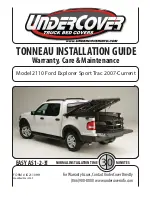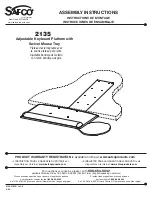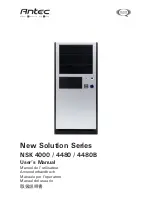
21
14
INSTRUCTIONS
(continued)
PACKAGING
The Post Driver is shipped as four (4) bundles.
1. The driving ram assembly, on a pallet.
2. A hydraulic package for the ram, in a carton.
3. The loader frame with loader mounting brackets.
4. If a manual unit – the manual adjusting base and
frame.
5. If a hydraulic unit – the hydraulic base mount unit,
partially pre-plumbed.
A hydraulic package for the hydraulic base, in a
carton.
Please inspect these bundles for any obvious signs of
damage before attempting to assemble the Post Driver.
Unpack all the bundles and lay out the various parts.
ASSEMBLY & MOUNTING
The following procedure is recommended for assem-
bling the front loader mounted Post Driver. Carefully
follow instructions for final assembly.
Before attempting assembly check the following items.
Having all the needed parts and equipment readily at
hand will speed up your assembly task and will make the
job as safe as possible.
• Check for fasteners and pins that were shipped with
the post driver. Some hardware coming from the fac-
tory has been installed in the location where it will be
used. If a part or fastener is temporarily removed for
assembly reasons, remember where it goes. Keep the
parts separated.
• Have a fork lift or loader along with chains and safety
stands that are sized for the job ready for the
assembly task.
• Have a minimum of 2 people at hand during assembly.
• Check to see that all nuts are properly tightened.
Remove the bucket from your front end loader. Check
your loader to make sure it is in good working order.
Check all frame mounting bolts to make sure they are
tight.
Loaders that attach to the tractor frame rails should
have a cross-tie installed for stability.
Refer to the “exploded view” of the Front Mounted Post
Driver on page 32 or 33 of this manual.
If your tractor loader has a bucket Quick Attach feature,
check with your dealer on the availability of adapter
brackets for your brand and model loader.
For pin type loader bucket mountings, the following
instructions apply:
Assemble the two lift brackets on the main frame with
the
5
/
8
” x 3” I.D. U-bolts. Leave the U-bolts loose.
NOTE:
The lift channel brackets are supplied with 1”
diameter pins to fit your loader. If your loader requires
1
1
/
8
” pins, it will be necessary for the hole diameter in the
channel brackets to be drilled out to 1
5
/
32
” (1.156”) and
ask your dealer to order 1
1
/
8
” diameter pins. The 1
1
/
8
” pins
are part #830318. Be sure to indicate if two or four 1
1
/
8
”
pins are required.
If your loader requires 1
1
/
4
” diameter pins, please ask
your dealer to order adapter bushings (part #830319). Be
sure to indicate how many adapter bushings are
required.
NOTE:
The Ford Model 7109, 7209, 7210 and 7410
Loaders require special mounting brackets instead of the
standard lift channels supplied. Order #830330 for this
application.
Connect the above assembly to the loader arms using
the bottom hole in the channel and attach the upper con-
trol cylinder to the top hole in the lift channels. Center the
main frame (side to side) with your loader arms and
tighten the four (4)
5
/
8
” x 3” U-Bolts.
The lower hole positions in the lift channels can be used
to obtain more angle movement. However, if the frame
becomes too parallel with the loader lift arms, the loader
may not have enough power (mechanical advantage) to
bring the frame back.
NOTE:
Generally, it is not recommended to have the tilt
cylinders located any closer than 10-12 inches to the
main loader lift arms. Check the spacing of mounting pins
on your loader bucket and use this as a guide.
The tilt cylinders should be located as far away from the
main loader arms as possible. This provides the most
stable attachment and will minimize movement and
forces placed on the loader by the post driver.
If tilt cylinders are located too close to the loader arms,
they may go “over center” when fully extended. If this
happens, damage may occur to the cylinders and/or
mounting brackets. (This situation should never occur
with the post driver mounted.)
SERVICE INSTRUCTIONS
(continued)
FIG. J
MAINTENANCE AND
ADJUSTMENTS
(continued)
HYDRAULIC CYLINDER BASE AND
ROD END ADJUSTMENT
Due to the design of the Driver carriage, it is necessary
for both the base and rod end of the hydraulic cylinder to
have a slight amount of freedom. This adjustment should
only be necessary if the hydraulic cylinder is removed for
servicing (see Figure J).
DISASSEMBLY – CARRIAGE AND RAM ASSEMBLY
1. Lay the driving ram assembly face down on the floor
or on a solid workbench.
2. Remove the transport lock pin. This will allow the ram
carriage to move up, thereby relieving the spring ten-
sion. Disconnect the upper spring bracket.
3. Remove the lock nut from the top of the cylinder rod
and push the rod back into the cylinder.
4. Now remove the hex nuts holding the transport lock
pin bracket in place. Slide the carriage down and
remove the hydraulic cylinder and springs as a unit
from the lower end.
5. The carriage can now be removed from the upper end
of the ram assembly.
HYDRAULIC CYLINDER DISASSEMBLY
1. Remove the hydraulic cylinder from the carriage.
2. Place the base end of the hydraulic cylinder in a vise,
support the upper end of the cylinder and unscrew the
aluminum cap. DO NOT remove the cap over the
upper threaded end of the cylinder rod.
3. Pull the rod from the cylinder tube.
4. Remove the nut from the lower end of the cylinder rod.
The rod should be protected with leather, cardboard
or wood blocks and placed in a vise to remove the nut.
Remove the aluminum rod guide. Now slide the cap
down the cylinder rod and remove it from the bottom
(unthreaded) end.
CAP SEAL REPLACEMENT
1. Use a screwdriver or knife to remove the old seal.
Soften the new seal by placing it in warm water or
direct light from a lamp. Squeeze the new seal
together and place one end of it in the seal groove.
Force down on the other end of the seal, and it will
snap into place. Inspect the seal to be sure it is
properly seated (see Figure K).
SPRING REPLACEMENT
1. Lower the driving ram so the springs are in their
relaxed position. Remove the upper spring bracket
from the square tube by removing the
3
/
8
” bolt holding
it in place.
2. Remove the upper spring clip from the spring bracket
by rotating the clip and sliding it out the keyhole slot in
the bracket.
3. Insert a screwdriver in the spring clip and screw it out
of the spring coils. The spring can be removed from
the lower spring clip by rotating the spring.
4. Install new spring clips by
inserting a screwdriver in the
end coil and screwing the clip
onto the first two coils (see
Figure L). Use a large pair of
adjustable (water pump) pliers
and close the ends of the spring
clips to retain them on the
spring.
2. Oil the new seal and slide the cap onto the cylinder
rod from the bottom end. Do not slide the cap on over
the upper threaded end of the rod. This will damage
the seal.
3. Replace the rod guide and retaining nut. Be sure to
protect the rod with leather, cardboard, etc., when
holding the rod in a vise for tightening the nut. DO
NOT hold the rod with a pipe wrench.
4. Insert the rod assembly in the cylinder tube. Place the
base end of the cylinder in a vise and support the
upper end. DO NOT tighten the vise on the cylinder
tube, as this may collapse the tubing. Use a good
grade hydraulic thread sealer and tighten the
aluminum cap.
FIG. K
FIG. L
5.
NOTE:
It is advisable to install a new rod guide, cylin-
der cap and seal as a unit when rebuilding the cylin-
der. Also inspect the cylinder rod for pits and/or rust
and replace if necessary.















































